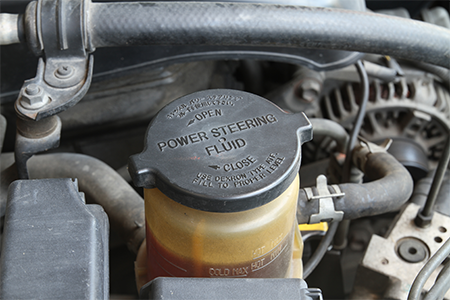Power Steering Warning Light (What Causes It?)

The power steering warning light coming on in your car is bound to make you worried, especially as it tends to coincide with a total loss of power steering, making it much harder for you to steer your vehicle.
If you’ve ever driven a car with manual steering, you know how hard it can be. If you’ve always driven cars with power steering, suddenly losing it can be a shock.
What Is Power Steering and How Does It Work?
Imagine trying to manoeuvre a car into a tight parking space without power steering. It would be a battle against the weight of the wheels, especially at low speeds. Thankfully, most modern cars come equipped with power steering, a system that takes the strain off your arms and makes driving a breeze.
There are two main types: hydraulic and electric. Hydraulic systems use a pump driven by the engine to push special fluid through pipes. This fluid then pressurises chambers within the steering mechanism, helping to turn the wheels.
Electric power steering (EPS), on the other hand, is a more recent invention. It relies on an electric motor powered by the car’s battery. This motor applies additional torque to the steering system, assisting you in turning the wheels.
No matter the type, power steering makes driving, particularly at low speeds and during parking manoeuvres, significantly easier and less demanding on your muscles.
What Does the Power Steering Warning Light Mean?
The power steering warning light on your dashboard is like a flashing red (or amber) SOS signal from your car. It means something’s not quite right with the system that keeps you safely in control.
Ignoring this light is a recipe for trouble, as proper steering control is absolutely vital for safe driving. When this light illuminates, it could indicate a few different culprits.
The most common is low-power steering fluid. This fluid plays a crucial role in transferring power within the system, and if it’s running low, you’ll feel a significant increase in the effort required to turn the wheel.
Other possibilities include a failing pump or motor (depending on whether your car uses a hydraulic or electric system), or even a leak in the system itself.
Any of these issues can lead to difficulty turning the wheel, especially at low speeds, which can significantly increase the risk of an accident. Don’t take the chance – if you see the power steering warning light come on, pull over in a safe place as soon as possible and get your car checked out by a qualified mechanic.
What Causes the Power Steering Light to Come On?
For vehicles with hydraulic power steering, the most common reason for the power steering warning light is that the fluid level is low. This is often caused by a leak in one of the hoses.
If you’re driving along and you notice your power steering light come on – which looks like a steering wheel with an exclamation mark next to it – you should park your car in a safe place as soon as you can, taking extra care as you’ll be struggling a little with much heavier steering.
Open your bonnet and locate your steering wheel fluid reservoir. This may have an image of a steering wheel on the cap. If not, you may need to consult your owner’s handbook to help you find where it is.
Have a look at the fluid level. If it looks a little low, you’ll need to top up the reservoir with more fluid before you continue on your journey. You probably won’t have any to hand so you’ll have to pop to your local supplier to pick some up.
Once you’ve topped up your power steering fluid, start your engine. If the warning light doesn’t come on again, you may continue on your journey. If the power steering light remains illuminated, it’s the sign of something more serious and you should take your car to your local garage as soon as possible to have the problem diagnosed.

How To Fix Your Power Steering Warning Light:
While some folks might be tempted to grab a spanner and fix the power steering themselves, it’s generally best to leave this to a qualified mechanic. Diagnosing the problem requires specific tools and expertise.
For instance, a mechanic might need to connect your car to a diagnostic computer to pinpoint the exact issue. Depending on the problem, repairs could involve anything from simply refilling the fluid to replacing a faulty component, or even fixing a leak.
If you notice the power steering warning light come on, play it safe and get your car checked out by a professional as soon as possible. It’s a small investment that could save you from a much bigger headache – or worse, an accident – down the road.
How To Check Your Power Steering Fluid:
Maintaining proper power steering fluid levels is essential for the system to function smoothly and safely. This fluid, typically a reddish-brown colour, plays a key role in transferring power within the system.
Checking the fluid level is a relatively simple task you can do yourself, although it’s always best to consult your car’s owner’s manual for the specific location and procedure for your vehicle.
Generally, it involves finding the power steering fluid reservoir under the bonnet and ensuring the fluid level falls within the designated markings on the reservoir. If the fluid level is low, you might need to top it up with the recommended type of fluid. However, keep in mind that this might indicate a leak in the system.
So, if you find yourself needing to add fluid frequently, it’s a good idea to get a professional to take a look and make sure everything is in tip-top condition.
What Does the EPS Warning Light Mean?

EPS will come on in vehicles that do not have hydraulic power steering. Rather than use hydraulics, the control module in the EPS system receives information from the steering angle sensor. This, in turn, controls the steering motor to provide power-assisted steering.
If you see the EPS warning light come on in your vehicle, you won’t have any fluid levels to check, so it may be more difficult to find out what’s causing the light to come on.
It can sometimes be caused by a fault with the battery or alternator, so you can carefully check all connections to the battery and see if there’s any visible wear or damage.
This issue with the EPS light can also be caused if you have recently had to jump-start your car, or you’ve disconnected the battery.
Occasionally, the problem can be fixed by simply turning your vehicle off and on again. If this does work, you should still take your vehicle to your local garage to be checked as there could be an underlying issue.
Is It Safe to Drive with The Power Steering Light On?
It’s not going to be easy, as the steering will be heavier and turning will be more difficult. It will also be almost impossible to react to events at higher speeds, so accidents will be far more likely.
If the light comes on when you’re near home, you’re probably alright to continue your journey safely, taking extra care, however, if you’re far from home we would recommend that you stop as soon as possible and inspect your car in a safe place.
Either way, the steering wheel warning light can be a clear sign that something is wrong with your power steering system and you should have your car inspected by a qualified technician as soon as possible.
If you’ve seen another warning light and you’re unsure what it is, you may want to read Dashboard Warning Lights Explained.
Blog Comments
To view, comment or reply to comments you must be logged into facebook
Related Articles
Other Articles
06 Sep 2023
18 Jun 2024



